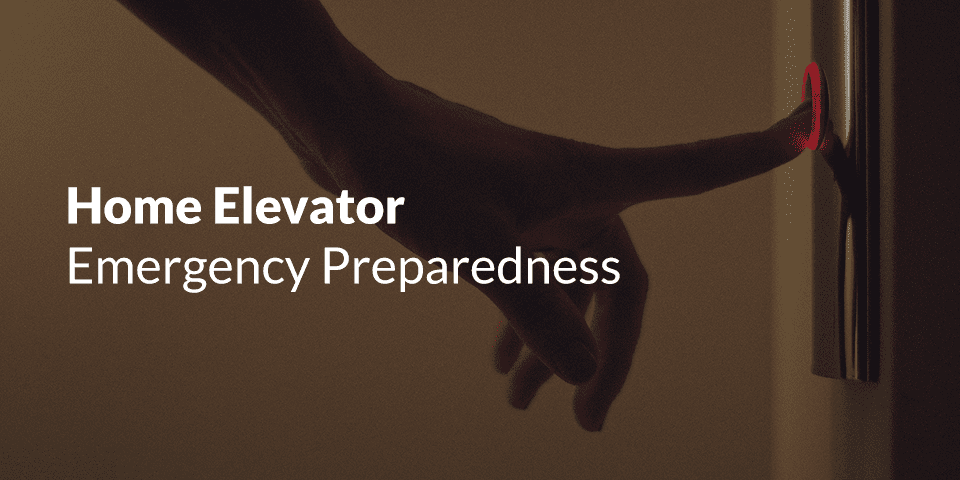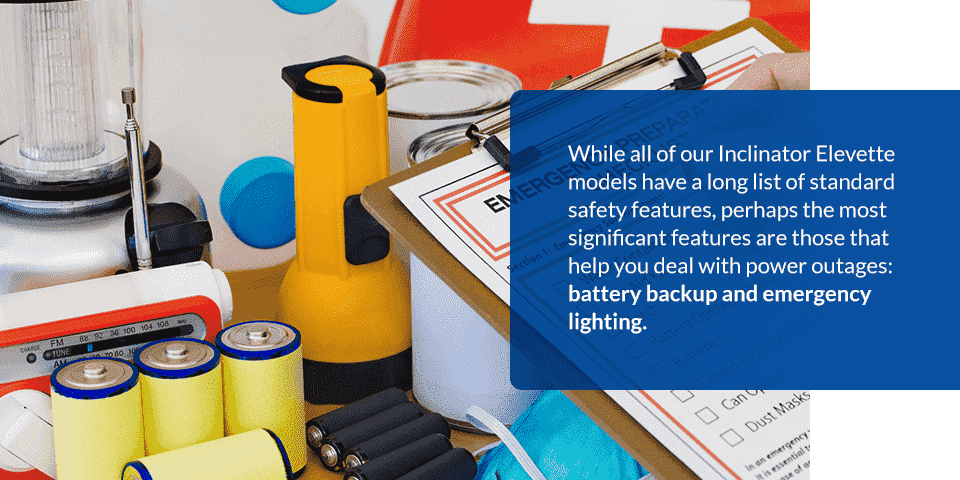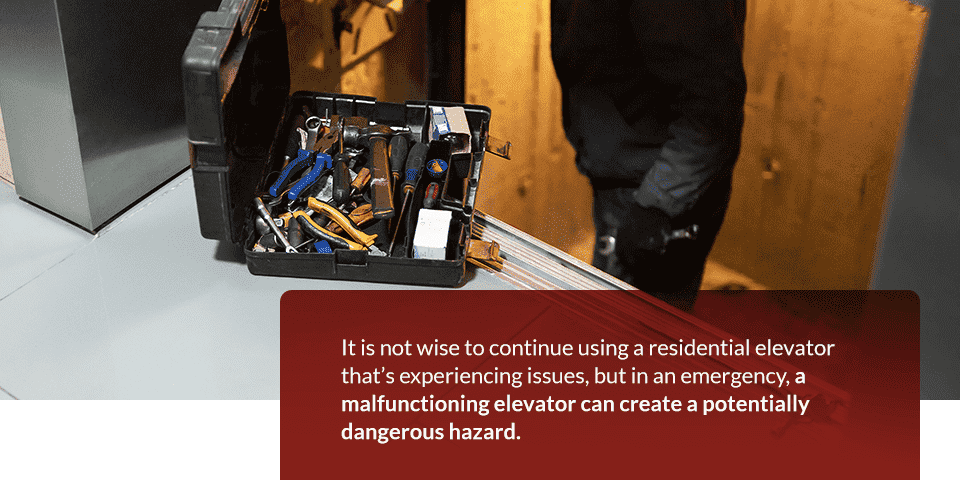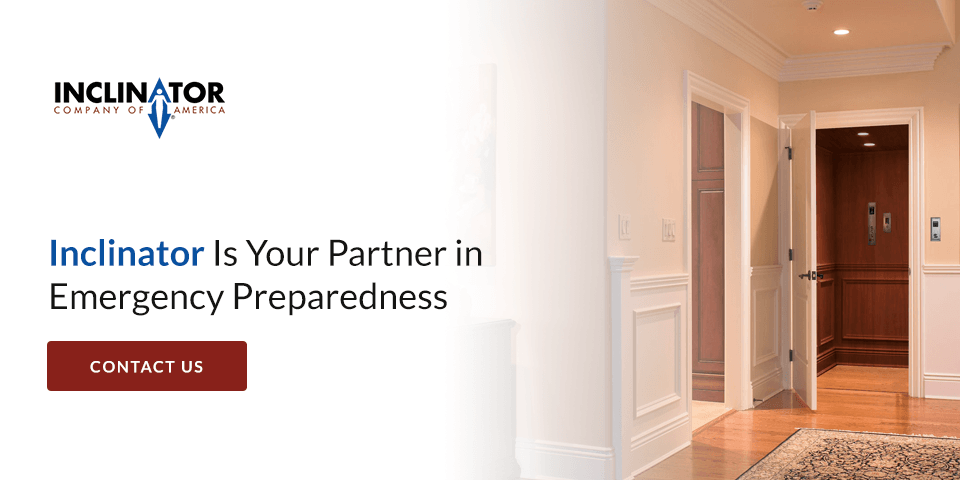Just because most emergency situations occur without warning does not mean that you shouldn’t be prepared. That’s why we design our Inclinator home elevators with a variety of important, code-compliant safety features to give you greater peace of mind.

Hopefully, you will never experience a catastrophic emergency in your home, such as a damaging fire or flood. If the unthinkable happens, or even if you experience power outages for non-emergency reasons, you can feel confident knowing your residential elevator will not present a risk to your family’s safety. And there are several actions you can take to help protect your elevator in certain situations, as well.
Today we’re taking a closer look at the built-in safety features of every Inclinator elevator, as well as what to do in emergencies involving your elevator.
Safety Features for Emergency Responsiveness
While all of our Inclinator Elevette models have a long list of standard safety features, perhaps the most significant features are those that help you deal with power outages: battery backup and emergency lighting.

Battery Backup
Indeed, a power failure in your home may not be due to a serious emergency, but the old trope of being stuck in an elevator during a blackout is recognizable to just about everyone because power outages are quite common. Inclinator home elevators come standard with battery backup, which lowers the cab to its lowest designated landing and opens the door if the power goes out. This means you won’t have to worry about the situation you’ve seen on TV – your Inclinator residential elevator has been carefully designed to allow you to safely exit during a power failure.
When the power goes out, your elevator will shut down immediately. This can lead to a sudden stop while moving between floors, which can make it feel like you are in a precarious situation when you are not. Hydraulic home elevators use electromagnetic brakes, which are normally held open by an electrical coil. Once the power supply is cut off, the coil disengages and the brake stops the elevator immediately.
After your elevator comes to a full stop, the backup battery will kick in. Depending on the system, the elevator will make a single trip that sends you to the nearest floor — or, most commonly, the ground floor. The doors will open as they do normally, allowing you or other passengers to exit quickly and in an orderly fashion while waiting for assistance to arrive.
Without a battery backup, the elevator will not plunge or fall, and there is no reason to panic. However, the brake will hold the elevator in place until assistance arrives. In this case, you will just have to wait until emergency personnel arrive to rescue you. If stuck in an elevator without battery backup, follow these steps:
- Try your best not to panic. You won’t fall, and you won’t run out of oxygen because all elevators are required to have adequate ventilation.
- Find the emergency phone, and tell the person on the other end your location and what happened.
- If you don’t have an emergency phone, you can hit the alarm bell button or call for help using your cell phone.
- Never attempt to pry open elevator doors or the escape hatch. You run a large risk of injuring yourself and may cause damage to the elevator itself.
- Once help arrives and gets you out of the elevator, don’t enter it again until a licensed technician or mechanic puts it back in service.
Choosing a home elevator with a battery backup or having one installed is a cost-effective way to minimize stress during a potential power outage.
Emergency Lighting and Alarms
Emergency lighting and alarm bells are also standard safety features on all Inclinator Elevette models, which can help in power outage situations. For example, if you need assistance from others during an outage, you can stay by your elevator and activate the alarm to be located faster. It is important to remember that this safety tip does not apply in fire emergencies. Always exit your home as quickly as possible in a fire.
When the power goes out in a situation other than a fire emergency, backup lighting can be vital for keeping the people in the elevator calm. As soon as the power goes out, an elevator’s emergency lights come on so occupants can see what’s going on and take appropriate action to call for help with the use of the on-board phone or alarm function.
Emergency lighting for residential elevators usually has its light board separate from the main lighting and connected to an alternate source of power. It may be wired directly to a generator or emergency backup battery, and many have their internal battery source that powers only the light system.
Emergency lighting systems are commonly powered by a 12-volt battery that may or may not be rechargeable. Checking the emergency lighting system is a part of routine maintenance, ensuring that you will still be able to see clearly if the power goes out while the elevator is in use. Emergency lighting should come on almost seamlessly, with only a few seconds between the power going out and the lights illuminating the elevator. A properly functioning lighting system will minimize distress and facilitate the next steps in handling the emergency.
Optional Phone in Cab
While we often have our cell phones with us at all times these days, wouldn’t it be comforting to know that you have another emergency telephone option in your home? As an add-on safety feature, we offer a flush-mounted speakerphone in our elevator cabs that has a manual dialer keypad and two-way conversation capability. If you’ve misplaced your cell phone or do not have a working landline phone when the power is out, you can use your Inclinator home elevator’s phone to call for help, whether you need to call 911 or a friend or family member.
Be Prepared for Emergencies at Home
While we can’t predict when emergencies will strike, we often have warnings for things like hurricanes and potential flooding. It also helps to have general preparedness plans in case the worst should happen.
Fire Safety
Have a pre-determined fire escape plan that involves several scenarios depending on where a fire might be located in your home and where you might be. For example, your escape route may vary if you are on an upper floor and the fire is in the basement versus the opposite situation.
Your plan must also take into account that elevators should never be used to escape during a fire. Flames and smoke could infiltrate the cab, or you could reach a landing and be blocked by fire. Your elevator’s power source and battery backup system could also be damaged or destroyed, causing your elevator to malfunction and stop between landings.
Your goal in a fire emergency is to exit the building as quickly as possible, and there are too many ways that elevators could hinder that quick exit.
Storm and Flooding Safety
In the case of hurricanes, tropical storms or intense rains that may cause flooding, you may be called on to evacuate your home, especially if you live in a floodplain or near bodies of water prone to flooding. If you must leave your home and have time to prepare, you can help your elevator weather the storm by assuring it is powered off after running it to its highest landing.
Once the storm and flooding danger has passed, even if you did not get much water inside your home, contact a residential elevator service provider, such as our Inclinator Elevators & Lifts service and repair division in the Philadelphia and southern New Jersey region, to inspect and restart your elevator.
If you live in a floodplain and are considering installing a new elevator, contact us to talk about steps we can take to protect your investment. For example, we can designate a default landing for your elevator that would never be underwater in a flooding emergency.
Routine Maintenance Is Part of Your Emergency Preparedness Plan
Speaking of service and repair, one of the best ways to be prepared for an emergency with your home elevator is to ensure that it is operating as it should. Routine elevator maintenance, which should be performed at least annually, includes safety checks and diagnosing problems. Depending on your service provider, maintenance plans may be available, which often offer a discount on parts and labor for repairs.

It is not wise to continue using a residential elevator that’s experiencing issues, but in an emergency, a malfunctioning elevator can create a potentially dangerous hazard.
Residential elevator maintenance can save you from experiencing any of these problems with your elevator:
- Misaligned motor drives, can cause excessive and dangerous wear on the shaft and require expensive component replacements.
- Contaminated oil, can increase general wear and tear and indicate more severe issues with the elevator.
- Power failures, which are not dangerous due to the battery backup on Inclinator elevators, but can be stressful and inconvenient.
- Worn sheaves, must be inspected regularly to ensure they are properly gripping the elevator cables.
Upon purchasing your elevator and finishing the installation process, you should receive a schedule for recommended maintenance from your elevator company. Typically, the recommendation is to have inspection and maintenance completed once or twice a year, depending on the elevator model you have chosen and where you are located. Many local regulations require homeowners to have inspections done more frequently than once a year to help minimize the risks of poorly cared-for elevators.
What Happens During Inspection and Elevator Maintenance
When it’s time for your routinely scheduled inspection, a technician from the elevator company will arrive at your home with a list of crucial components to check. If you have any questions or concerns about the elevator and the way you’re using it, the technician will be happy to answer. The usual points of inspection include:
- The gate
- Hoistway door sensors
- Hall station buttons
- Interior operation controls
- Emergency systems
Once all the above systems are verified to be in working order, the technician will also check for the amount of wear on these systems and components:
- Drive system
- Fastening anchors
- Travel cables
- Rail system
Certain small repairs or maintenance requirements can be completed immediately, such as adding more lubricant. If other repairs are needed, Inclinator makes it easy to get a quote and appointment to get your elevator back in excellent working order.
Preserve Preparedness Through Proper Use
While all Inclinator hydraulic home elevators are designed to be durable for long-term use, you can take several steps to keep it in the best working order and minimize the effects of an emergency where the power is still on:
- Pay attention to your elevator’s weight limit. Find out the exact limit specified in the manual and ensure you never exceed the limit.
- Stay away from industrial cleaners. They are so harsh that spraying them inside your elevator can result in corrosive chemicals getting into small cracks and ruining components along with finishes.
- Keep a basic log of your use of the elevator for comparative purposes, and be sure to write down the date and time you notice a particular issue occurring.
By being proactive with maintenance and using your home elevator properly, you can help make sure that your elevator is in the best condition to handle any type of emergency.
Inclinator Is Your Partner in Emergency Preparedness
At Inclinator, we understand the importance of home elevator emergency preparedness, and we offer hydraulic home elevators and cable drum lifts that meet rigorous safety standards. If you have any questions about how to prepare your elevator for an emergency, Inclinator can help. Give us a call at 800-343-9007 or fill in our contact form to find out more.
- 7 Signs You Need a Residential Elevator - December 7, 2023
- Home Investments That Help You Age in Place More Comfortably - October 12, 2023
- 3 Misconceptions About Home Elevators - December 9, 2021







